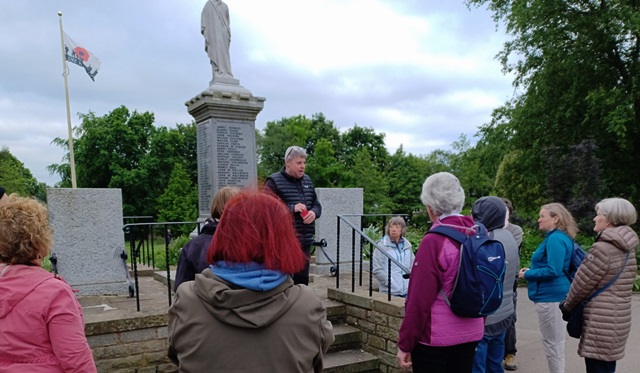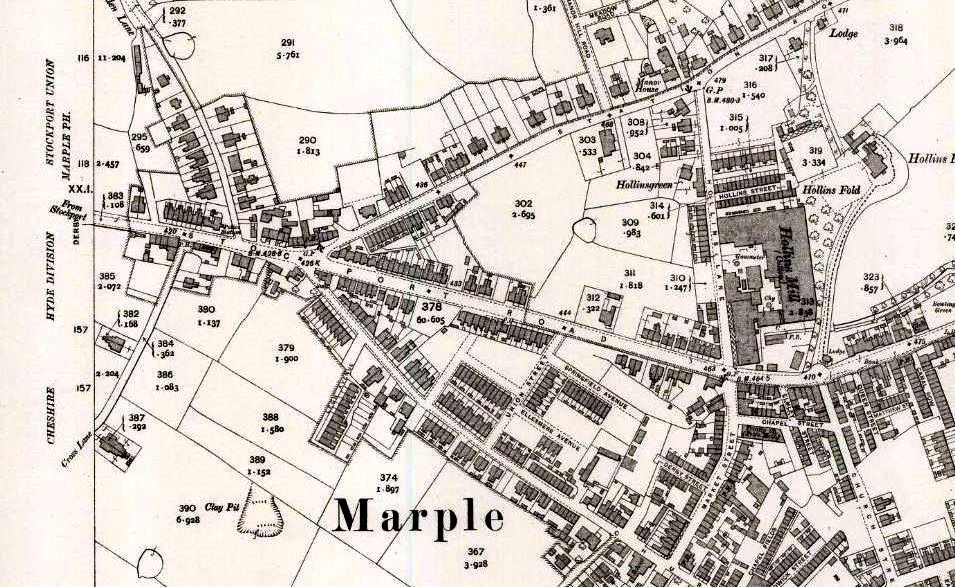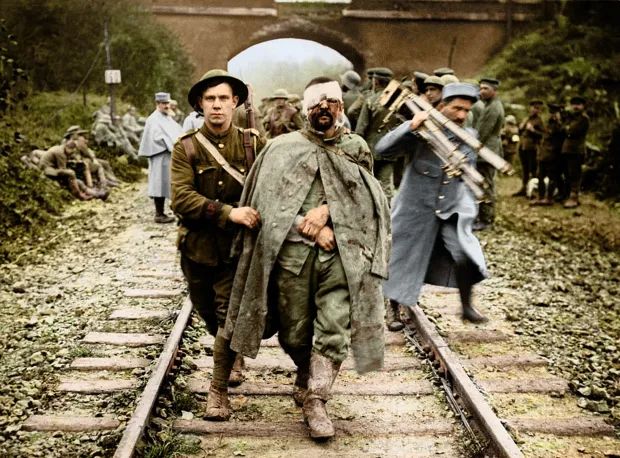After assembling at Marple’s War Memorial on a grey and damp evening, fourteen society members and friends were guided by Andy Cook through both the streets of Marple and the effects of the Great War on the town. Andy is a co-author of the 1999 book “Remembered, Marple Men Who Fell in the Great War.”

The evening’s route encompassed Stockport Road, Market Street, Derby Way, and Church Lane, with a return to Memorial Park via Stockport Road and Hollins Lane. As the walk took us to Market Street and Derby Way, two realisations came to mind. First that many of now ‘shops’ were houses in the 1910s but far, far more importantly, it brought home that in the much smaller, more tightly knit Marple, to many a house, death had come drip by drip over four long years.

Andy Cook starts the evening
The town was bombarded with terrible, heartbreaking news for four relentless years. The loss of fathers, sons, friends, and fiancés among those 141 deaths that visited Marple. Pro-rata, with the 2011 census population of 23,500, the town would lose 520 men. The first death came a mere twelve weeks into the conflict: Fred Atkinson on October 24, 1914; the last death occurred a year after the end of the war in 1919, when John Hampson died on November 23rd.

The Marple of 1920
Great Britain declared war on Germany in August 1914. Within a year, it had become obvious that it was not possible to continue fighting by relying on voluntary recruits, reservists, and Territorials. Lord Kitchener’s campaign, promoted by his famous “Your Country Needs You” poster, encouraged over one million men to enlist by January 1915. But this recruitment fell short of keeping pace with mounting casualties. To bolster the number, the Military Service Act was passed by parliament in January 1916, introducing mandatory military service. Conscription being imposed on all single men aged between 18 and 41, but exempted were the medically unfit, clergymen, teachers, and certain classes of industrial workers. The Act was far from popular, with 200,000 in Trafalgar Square demonstrating against the Act in April 1916. By the end of the year, innocence and glamour had gone out of the war, driven out by the horror of the Battle of Somme.

The enormous loss of life in such a short space of time was a horror previously thought unimaginable in a supposedly civilized, sophisticated Europe. Up until the First World War, battles consisted of infantry squares, cannon fire, and cavalry charges. They took place on battlefields far removed from civilization and were usually over in a day.
Both sides saw the widespread use of poisoned gas during the First World War. The 90,000 deaths and countless horrific, life-changing injuries caused by this deadly new weapon led to the Geneva Protocol of 1925, which prohibited the use of chemical and biological weapons in warfare. Remarkably, all but a handful of rogue states have stuck to this agreement to this day.

Aftermath of a gas attack
Well-known local family, the Isherwoods of Marple Hall, lost their father at Ypres in May 1915. Owners of Hollins Mill, the Carvers, suffered the death of brothers Howard and Basil. Two of Howard and Basil cousins were lost too, Geoffrey Bagshawe, and at the hands of the ‘Red Baron,’ Harold Carver Barlow. Poorer families suffered in equal measure but suffered more, the loss of a son, brother, or husband meaning the loss, too, of guaranteed money that provided food and shelter. Such was the savagery of the war that six Marple men were lost on one day, July 31st, 1916, at the 3rd Battle of Ypres, or Passchendaele, as it is better known.

A British soldier helps a wounded German prisoner walk along a railway track Credit: www.mediadrumworld.com
During the dark days of 1918, when the Germans launched a massive offensive, breaking through the Allies' front line, a resident of Marple won the Victoria Cross. Lieutenant Colonel John Stanhope Collingswood-Wells showed ‘exceptional leadership and great courage’ when leading his battalion in a counterattack against the enemy lines. The award was posthumous as the lieutenant-colonel was killed by a shell. As the war drew to a close in the latter months of 1918, Marple was again hammered by sad, desperate news. The Hallworth family of Ivy Cottage lost three sons in fifteen months. Mrs. Pickford's two sons were killed, only 17 days apart.
There are over 70,000 war memorials in the country. During the war, British Forces casualties numbered 880,000. This represents 6% of the then-population and 12.5% of those who served, one in eight dying. The 1921 Census was testament to this loss; 109 women were recorded for every 100 men.
What’s often forgotten is that the British monarch at the time, George V, was the first cousin of Germany’s Kaiser Wilhelm II, both being grandchildren of Queen Victoria. The third major royal player in World War One, Tsar Nicholas II of Russia, also had a very personal stake in things. He was another first cousin of George V, whose mother, Alexandra of Denmark, was the sister of the Tsar’s mother, Dagmar of Denmark.
The trauma of the four years of war, produced a change in society. The needs on the Home Front meant that millions of women were given their first taste of paid work outside the confines of home. A wage packet that could prove the catalyst to find financial independence and freedom. The genie was impossible to put back in the bottle, laying the foundation for women's suffrage and feminist movements.

Emmeline Pankhurst was vital in securing women's rights to vote
There was also a change in the public’s perception of what armed conflict really meant. Used to a romanticised notion that war was played by stiff-upper-lipped gentlemen on faraway fields against hopelessly outgunned opposition, the carnage of the Great War opened people’s eyes to the true horror of war. As a result, the postwar period was marked by art, literature and philosophy that questioned the meaning of life in the face of death on such an unprecedented scale. And the hedonist Roaring Twenties, a decade of dissipation, jazz bands, raccoon coats, and bathtub gin.
Martin Cruickshank - June 2024
Our thanks to Andy Cook for an excellent and informative evening.
Further reading:-
WWI Timeline Tribute to the men on Marple War Memorial
The Great War BBC series of 1964
"The Great War is a 26-episode documentary series from 1964 on the First World War. The documentary was a co-production of the Imperial War Museum, the British Broadcasting Corporation, the Canadian Broadcasting Corporation and the Australian Broadcasting Commission. The narrator was Michael Redgrave, with readings by Marius Goring, Ralph Richardson, Cyril Luckham, Sebastian Shaw and Emlyn Williams. Each episode is c. 40 minutes long.
Each episode of The Great War was seen by an average audience of over eight million people, a 17 percent share of the estimated viewing population. The fourth episode, the most popular of the series, reached an audience of over eleven million (22.6 percent of the audience).






